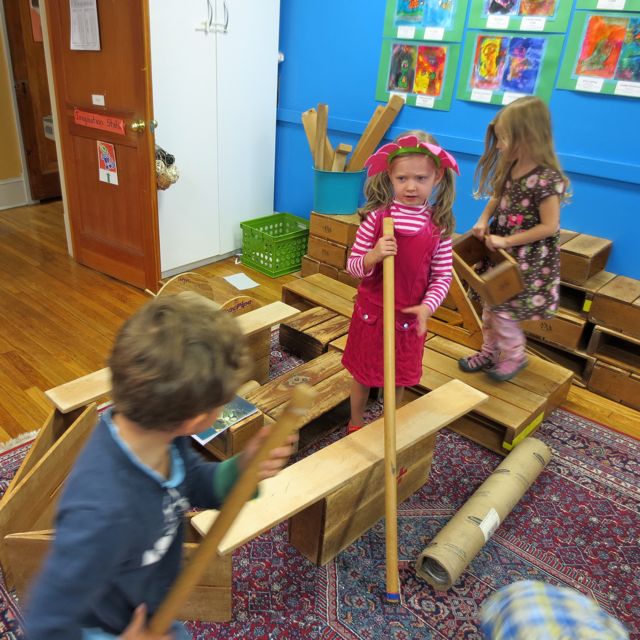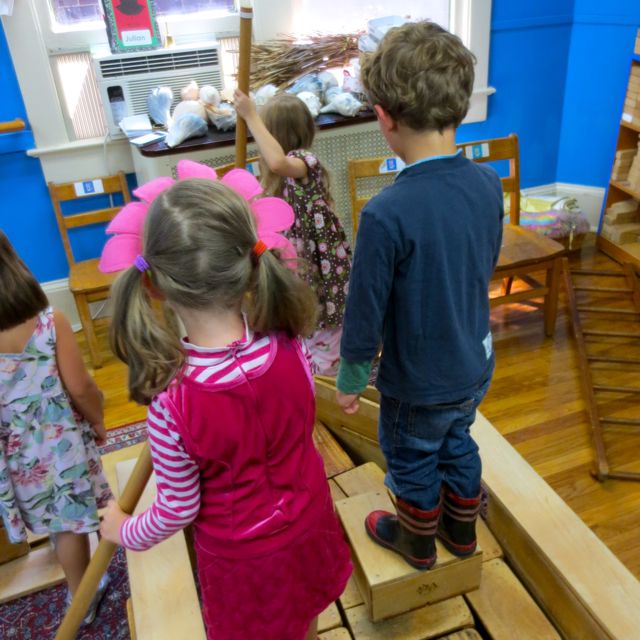A co-op mother gifted the National Endowment for the Arts' Picturing America box of laminated posters to the school. It is an incredibly rich resource. We have referred to a few key pieces as reference for visual art and will continue to do so, but on this day, as luck would have it, this wonderful resource took us in a whole new direction!
Last week, her husband brought in the companion book. I started strolling through it with one of our Tracks children and the book fell open to The Midnight Ride of Paul Revere...Win! Best book EVER our Track decided when I told him what the painting was about. It just so happens that he is (currently) very interested in the American Revolution, Civil War, etc.
The next painting we looked at was Washington Crossing the Delaware. He was forever and ever won over with Picturing America and everything in it. He wanted to BE Washington crossing the Delaware and guess what? That is called play!
Only a short time later, we found ourselves in Imagination Station reenacting the crossing of the Delaware and it proved to be a very bumpy ride. Almost as bumpy as finding yourself on an icy river without a stitch of polar fleece during the Revolutionary War. I tell this story because in the attempt, the failure, and the eventual, but measured, success to reenact this event -- all very public, every other Track was involved in either engaging with him or not -- and there were some very real life skills gained for all. Information was shared, processed, considered, and either embraced or not. So, here is how it played out...


The sell... He tries to convince others to "follow the map!!!!!" during the first session of drama (we have two 45-minute sessions). At first, several of them got behind the boat-building part, but eventually interest dwindled. And by eventually, I actually mean after one or two blocks. It was a no-go. They felt too constrained by The Map and the person with The Map had very, very specific ideas about how to follow it. It was tough.

So he tried to do it alone, while the others watched during breaks in their own play scenarios.
I told him that he should come back in the second group and try to sell them on the idea. I helped him build the boat to get a closer representation of the boat-ness and talked to him about what he thought was missing. This was time well spent, because he was able to refine his pitch for the new group of children and they could see the outline of the boat and it all gelled for them, for a minute...

They couldn't quite find their way into it completely. This might have been because he wanted the play to go exactly a certain way and while he approved the use of swords in the play, drawing on prior knowledge of the whole Revolutionary War bit, he could not accept them being used to push off the ice floes (being played here by cardboard tubes). The picture above captures the moment just before one of the sailor-soldiers said, "I want to be on Washington's Delaware boat during the Tinkerbell part." She then cheerfully skipped off over the icy Delaware followed by the other sword fighters to play family.
In the meantime, much negotiation was begun about how big the Delaware had to be because it left little to no room for the giant rocket ship another group wanted to build. Compromise was struck, borders were drawn, but it was a fragile state of affairs all the same. That's what happens when you negotiate borders.
Finally, the stalwart soldier-sailor-Washingtons consisted of three children and it was a very interesting mix of children. These three all want things to be a certain way and yet, together, they were able to meld and blend their ideas. It is as if The Map gave them each permission to feel independent and in charge of the play and yet they were playing together and making collaborative decisions.
This hour and twenty minute experience cannot be planned. How can you plan for interest, failure, and partial success? It just happens. This event was unique to this day and this group and it was helped along by an interest, willingness, and the ability to walk away and still be friends while looking for willing partners in a common pursuit.
p.s. Later in the week, I pulled out the large laminated painting of Washington Crossing the Delaware from the boxed set. It was amazing how much more detail we were able to find in it compared to the one in the book. There were horses and more boats. We were able to talk about the clothes that they were wearing. Why didn't they have uniforms our soldier-sailor-general wanted to know. We wondered if we could see the original, would we be able to see even more in the painting? Road trip to the Met anyone?







